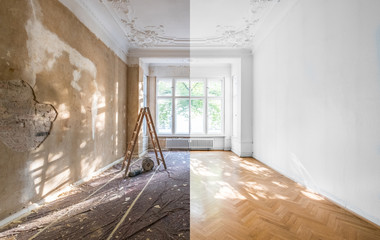Home restoration is more than just fixing what’s broken—it’s about bringing a property back to life, preserving its charm, and enhancing its functionality. Whether you’ve recently purchased an older home or are looking to rejuvenate the space you’ve lived in for years, restoration can transform your environment into something beautiful, efficient, and enduring. By understanding the fundamentals of home restoration, homeowners can plan projects that respect the past while embracing modern comforts.

Understanding Home Restoration
Home restoration differs from remodeling or simple repairs. While remodeling focuses on altering or modernizing spaces, restoration emphasizes returning a home to its original condition or maintaining its unique features while updating systems for today’s needs. This approach is particularly valuable for homes with historical or architectural significance, where preserving original materials and details is a priority.
However, restoration isn’t limited to historic homes. Even newer houses benefit from thoughtful restoration, which can address wear and tear, improve energy efficiency, and elevate overall appeal.
Assessing the Condition of Your Home
The first step in any restoration project is evaluating the property’s current state. Conduct a thorough inspection to identify areas that need attention, including:
- Structural components like the foundation, roof, and framing
- Plumbing, electrical, and HVAC systems
- Walls, floors, and ceilings for water damage or deterioration
- Original features such as woodwork, trim, and built-ins
Documenting these conditions helps create a clear plan and budget. It also ensures that critical safety issues are addressed before focusing on aesthetics.
Preserving Original Features
One of the most rewarding aspects of home restoration is preserving or replicating original elements. Features like hardwood floors, crown moldings, fireplaces, and staircases add character and authenticity to a home. Where possible, restoring these details rather than replacing them can enhance both sentimental and market value.
Techniques might include refinishing old wood, repairing plaster walls instead of replacing them with drywall, or sourcing period-appropriate fixtures. These choices maintain the home’s integrity while blending seamlessly with necessary upgrades.
Updating Essential Systems
While the goal of restoration is to maintain the home’s original charm, updating essential systems is non-negotiable for safety, comfort, and efficiency. Modern plumbing, electrical wiring, and heating and cooling systems ensure the house meets current codes and environmental standards.
Energy efficiency upgrades—such as installing insulation, sealing drafts, and using efficient appliances—can be integrated into restoration projects without compromising historic character. This approach keeps utility costs manageable and creates a more sustainable home.
Interior Finishes and Aesthetic Touches
Once the structure and systems are sound, attention can turn to finishes and aesthetics. Carefully selected paint colors, flooring, and lighting can highlight architectural details while creating a welcoming atmosphere. For homes with vintage elements, neutral palettes often work well to showcase woodwork, tile, or decorative accents.
Homeowners might also consider repurposing or restoring original fixtures. For instance, a vintage chandelier can be rewired and reused, or old cabinets refinished for a fresh yet authentic look.
Exterior Restoration and Curb Appeal
The exterior of a home is just as important as the interior. Restoration projects often include repairing or replacing siding, windows, and roofs while maintaining the home’s original style. Landscaping, walkways, and porches can also be revitalized to boost curb appeal.
A well-maintained exterior not only preserves the property’s integrity but also increases its value and longevity. Simple steps like repairing masonry, restoring wooden trim, and repainting in period-appropriate colors can dramatically improve a home’s appearance.
Planning and Budgeting
Home restoration projects can be complex and often take longer than anticipated. Creating a detailed plan and a realistic budget is essential. Break the work into stages, starting with the most urgent structural or safety concerns before moving to cosmetic improvements.
Set aside a contingency fund for unexpected issues that may arise once walls are opened or floors lifted. Being flexible and prepared can help minimize stress during the restoration process.
Balancing Modern Comfort with Traditional Charm
One of the greatest challenges in home restoration is balancing modern living needs with a property’s original design. Open floor plans, updated kitchens, and additional bathrooms are common desires in older homes. When making these changes, consider ways to integrate them without erasing character.
For example, a new kitchen can feature cabinetry that mimics the style of the original woodwork, or modern bathrooms can incorporate vintage-inspired tiles and fixtures. This approach creates harmony between old and new, resulting in a space that feels timeless rather than dated.
Environmental Benefits of Restoration
Restoring a home is also an environmentally responsible choice. Instead of demolishing and rebuilding, restoration conserves existing materials and reduces waste. Many older homes were built with high-quality, durable materials that, when properly cared for, can last for decades more.
By improving insulation, sealing drafts, and upgrading systems, restoration projects also increase energy efficiency, lowering the home’s environmental footprint.
The Reward of Home Restoration
While restoration can be a significant undertaking, the rewards are well worth the effort. A restored home offers the comfort of modern living paired with the charm and craftsmanship of the past. It becomes a reflection of both the property’s history and the homeowner’s vision, creating a truly unique living space.
In many cases, restored homes also hold their value better and may even appreciate more than comparable properties. The care and attention put into maintaining original features and upgrading systems can be a strong selling point for future buyers.
Bringing It All Together
Home restoration is a journey of discovery, creativity, and respect for craftsmanship. By carefully assessing your property, preserving original features, updating essential systems, and balancing modern comforts with traditional style, you can transform your house into a space that feels both authentic and new.
This process is not just about improving a building—it’s about honoring its story and ensuring it continues to serve generations to come. With thoughtful planning and an appreciation for detail, any homeowner can breathe new life into their living space and enjoy the satisfaction of a truly restored home.